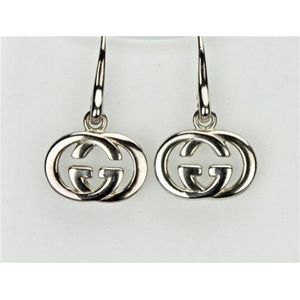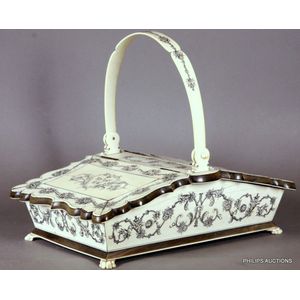Anglo-Indian Ivory Sewing Box with Floral Engravings
An Anglo-Indian Vizagapatam ivory and Lac engraved sewing box, mid 19th century, the twin lidded tapering box with a swing handle, having shaped edges and Arabesque and trailing floral border patterns throughout, centred with a monogram, and raised on paw feet, the sandalwood lined interior with a pierced partition, height 10 cm, length 31 cm, width 24 cm
You must be a subscriber, and be logged in to view price and dealer details.
Subscribe Now to view actual auction price for this item
When you subscribe, you have the option of setting the currency in which to display prices to $Au, $US, $NZ or Stg.
This item has been sold, and the description, image and price are for reference purposes only.
- Sandalwood - Sandalwood is a heavy, yellow coloured and very fine-grained timber, which has a fragrance which lasts for many decades, and acts as a deterent to moths and insects.
In the British colonial era, sandalwood was imported into Britain from India, and the wood also used within India for the manufacture of Anglo-Indian furniture.
Becasue it does not have a distinct grain pattern, sandalwood was not used for the exterior surfaces of furniture, but was put to use for drawer and box linings, where the aroma was noticeable one the object was opened. it was also used to manufacture small objects (treen).
Nowadays sandalwood is commercially grown with Australia the largest producer. As well as producing timber, oil is extracted for use in the manufacture of perfumes. - Ivory - Ivory is a hard white material that comes from the tusks of elephants, mammoth, walrus and boar, or from the teeth of hippopotamus and whales. The ivory from the African elephant is the most prized source of ivory. Although the mammoth is extinct, tusks are still being unearthed in Russia and offered for sale.
Ivory has been used since the earliest times as a material for sculpture of small items, both in Europe and the east, principally China and Japan.
In Asia ivory has been carved for netsuke, seals, okimono, card cases, fan supports, animals and other figures and even as carved tusks.
In the last 200 years in Europe ivory has been used to carve figures, for elaborate tankards, snuff boxes, cane handles, embroidery and sewing accessories, in jewellery and as inlay on furniture. Its more practical uses include being used for billiard balls, buttons, and a veneers on the top of piano keys.
The use and trade of elephant ivory have become controversial because they have contributed to Due to the decline in elephant populations because of the trade in ivory, the Asian elephant was placed on Appendix One of the Convention on International Trade in Endangered Species (CITES), in 1975, and in January 1990, the African elephant was similarly listed. Under Appendix One, international trade in Asian or African elephant ivory between member countries is forbidden. Unlike trade in elephant tusks, trade in mammoth tusks is legal.
Since the invention of plastics, there have been many attempts to create an artificial ivory - Arabesque - The arabesque pattern is an ornamental design that features flowing, curving lines and elaborate geometric shapes. It is inspired by the art and architecture of the Islamic world and was developed at Fontainebleu France in the mid 16th century. Its use was spread through published engravings, and it is characterized by its intricate and highly decorative nature. The arabesque pattern is created using a repetitive motif that is repeated and interwoven to create a cohesive design. It was used as a form of decoration in art, architecture, textiles, pottery, furniture and ceramics and it is often used to add a sense of grandeur and sophistication to a design. The arabesque pattern is admired for its beauty and complexity, and it continues to be used in a wide range of decorative contexts today.
This item has been included into following indexes:
Visually similar items

Dutch silver jewellery/trinket box 13.5 cm wide approx
Sold by
in
for
You can display prices in $Au, $US, $NZ or Stg.

A pair of Gucci silver earrings, on shepherds hooks, with original pouch and box.
Sold by
in
for
You can display prices in $Au, $US, $NZ or Stg.

A handbag by Louis Vuitton, styled in monogram Sabina weave with gold metal hardware, white leather trim and top handles, 26 x 36 x 12.5 cm
Sold by
in
for
You can display prices in $Au, $US, $NZ or Stg.

Sold by
in
for
You can display prices in $Au, $US, $NZ or Stg.
